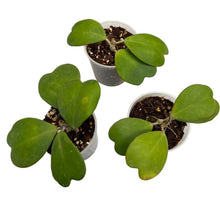9cm potted plant in a coco husk plug with coco coir, coco chips, perlite and pine bark. We do not recommend removing the plant from the coco husk plug.
The picture shown is an example of what's in stock. You will receive a plant as close to the picture and description as possible :)
Hoya kerrii is part of the Apocynaceae family and its native range is Indo-China to W. Malesia. It’s leaves are opposite, super thick and heart shaped. Hoya kerrii produces a large fibrous root system and will root readily at the nodes if the humidity is high enough. It is considered a consistent bloomer (in the right conditions), producing a globular cluster of 15-25 fuzzy reflexed flowers, they are white with a lime green tone and red centre, it’s worth noting the flowers drip a sticky amber coloured nectar.
Genus name is new Latin, named after Thomas Hoy ( c. 1750– c. 1821), English gardener. Specific epithet honours Arthur Francis George Kerr who first collected the plant in Thailand in 1910 or 1911.
Pot: ø 9cm.
Size: Minimum 3 leaves
Light: Bright indirect light, meaning the plant sees the sun for 0-4 hours per day - this could be through trees or a translucent curtain, it’s important for the plant to see the sky in order to thrive. An east-facing window is usually a good spot.
Water: Allow the majority of the mix to dry out as the mix is traditionally quite chunky, water will usually flow through quite easily. Be sure to thoroughly moisten the substrate.
Potting mix: A chunky well draining mix composed of coco coir, perlite or vermiculite, orchid bark, sphagnum moss and worm castings; you could also add some horticultural charcoal to this epiphytic mix. Alternatively, you can pot in a mix of coco chips and perlite.
Fertilising: Feed your plant every few waterings during the growing season or when you observe active growth. You can dilute fertiliser to half the recommended amount but never add more.
Temperature: 10-25˚C.
Humidity: Hoya prefer higher humidity, between 60-80% - they definitely grow better with higher humidity.
For further information about Hoya, check out our blog.
Hoya aren’t considered toxic, however, they may make your pet or child vomit if ingested, keep out of reach just to be safe.



